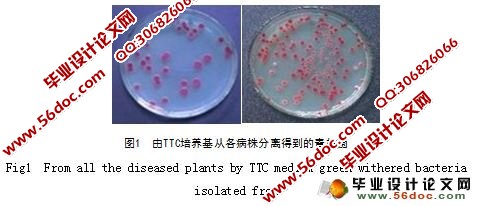湖南省茄科作物青枯病菌生理小种的分子鉴定(毕业论文10990字)
摘 要:青枯病是烟草上第一大细菌性病害,在我国南部烟区大面积发生流行,导致烟叶产量品质大幅度下降,造成很大的经济损失。目前使用有几种分子鉴定的方法对青枯菌进行鉴定,但这些方法耗时长,操作复杂,且不能直接有效的鉴定生理小种;本实验针对1号,2号,3号生理小种的设计了三对特异性引物, 通过PCR扩增,凝胶电泳与设计的PCR扩增片段大小比对,确定生理小种。结果表明,所得青枯病菌为生理小种1,3号(在国内暂时没有发现2号生理小种)。此法能快速有效的鉴定青枯菌的生理小种1,2,3,号;为烟草青枯病的进一步研究提供参考。
关键词:青枯菌;分子鉴定;生理小种
Molecular Charaterization of Ralstonia solanacearum Race1,2and3
Abstract: bacterial wilt is one of the main tobacco bacterial diseases,Solanaceae plants suffer from endangering the heaviest, In south China's large happen popular, tobacco region , Lead to tobacco production quality dropped , Currently using molecular appraisal methods of some of green withered bacteria for identification,But these methods are time consuming, complex operation, it cannot be directly effective identification physiological race; This experiment aimed at no. 1, no. 2, 3 design three pairs of specificity primer, Through the PCR, gel electrophoresis and designing of PCR segment size comparison, determine a Race.The results show that income.bacterial wilt bacteria for physiological small kind of 1 number (in domestic temporarily haven't found 2 physiological small kinds). This method can fast and effective identification of Race withered bacterium of 1, 2, 3, the trumpets; For the tobacco.bacterial wilt provide a reference for further research .
Key words:bacterial wilt; Molecular Charaterization; Ralstonia solanacearum Race

目 录
摘 要 1
关键词 1
1 前言 2
1.1 青枯菌的发生 2
1.2 青枯菌菌系的分类 2
1.2.1 按不同来源菌株对不同植物种类的致病性差异分类, 2
1.2.2 根据不同菌株对3种双糖和3种己醇氧化产酸能力的差异进行分类 2
1.3 病原及发病症状特点 3
1.4 茄科植物青枯菌的致病机理 3
1.5 青枯菌的传播途径及发病条件 4
1.5.1 传播途径 4
1.5.2 发病条件 4
1.5.3 青枯病田间发病动态 4
1.6 防治对策 5
1.6.1 采用农业措施 5
1.6.2 生物防治 5
1.6.3 化学防治 5
1.7 青枯菌的检测方法 6
1.7.1 传统组织分离方法 6
1.7.2 酶联免疫吸附法 6
1.7.3 分子生物学方法 7
1.8 实验方法对比 7
2 实验材料与方法 8
2.1 实验材料 8
2.1.1 样品采集 8
2.1.2 试剂与实验仪器 8
2.1.3 引物设计 8
2.2 方法 9
2.2.1 器皿的处理 9
2.2.2 培养基的制备 9
2.2.3 青枯菌的分离纯化 10
2.2.4 PCR扩增 10
2.2.5 凝胶电泳 11
3 结果与分析 12
3.1 样品采集与分离纯化 12
3.2 PCR鉴定 12
4 结论与讨论 13
参考文献 14
致 谢 15
|



